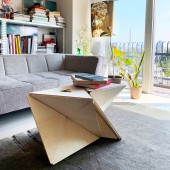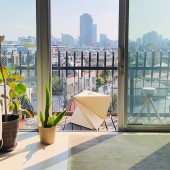
| THE AWARD |
| CATEGORIES |
| REGISTRATION |
| SUBMIT YOUR WORK |
| ENTRY INSTRUCTIONS |
| TERMS & CONDITIONS |
| PUBLICATIONS |
| DATES & FEES |
| METHODOLOGY |
| CONTACT |
| WINNERS |
| PRESS ROOM |
| GET INVOLVED |
| DESIGN PRIZE |
| DESIGN STORE |
| THE AWARD | JURY | CATEGORIES | REGISTRATION | PRESS | WINNERS | PUBLICATIONS | ENTRY INSTRUCTIONS |
Tatamu Folding Stool by Mate Meszaros |
Home > Winners > Design #100792 >Interview |
 |
|
FS: What is the main principle, idea and inspiration behind your design?
MH: Small apartments, narrow offices, tiny shops; urban space is a vanishing, precious commodity. By 2050 two thirds of the earth’s population will live in cities. We have to fit increasingly more activities in a shrinking physical space. The main inspiration behind Tatamu are mobile and creative people like us, whose ideas are bigger than their room. We also found that moving in and out of tiny city apartments often involves the disposal of old furniture, since transportation is very costly; we need light, deployable, reusable furniture that is a joy to use.
FS: What has been your main focus in designing this work? Especially what did you want to achieve?
MH: When we started designing the Tatamu stool, we aimed to create furniture that combines robustness with an ultra-thin and lightweight material, while being intuitive to use. It takes only one twisting movement to deploy the chair. We wanted to keep the design as simple as possible, so there are only two materials: wood and fabric. The hinges made of specially manufactured durable fabric keep it light weight, while the wooden origami faces provide stability. Once pressure is applied to it, the stool only gets stronger as the faces lock in together in perfect mechanical balance.
FS: What are your future plans for this award winning design?
MH: The Tatamu stool is the first furniture in a series of furniture answering to people needs with limited spaces.
FS: How long did it take you to design this particular concept?
MH: The design of the Tatamu Stool started in June 2019 with paper models and 3d modelling and we finalized the last prototype in January 2020.
FS: Why did you design this particular concept? Was this design commissioned or did you decide to pursuit an inspiration?
MH: Our personal inspiration to design the Tatamu stool came from living, working and socializing in tiny, vibrant, multi-functional spaces; our dream is to distill Tokyo urban lifestyle into everyday, functional and beautiful furniture. Furniture that adapts to, reacts to and interacts with our increasingly mobile lives.
FS: Is your design being produced or used by another company, or do you plan to sell or lease the production rights or do you intent to produce your work yourself?
MH: Our furniture is being manufactured by Penfold - a traditional Japanese furniture manufacturer. We intend to sell our furniture ourselves.
FS: What sets this design apart from other similar or resembling concepts?
MH: The Tatamu Stool is using unique solutions in its details, these joints can be used in the future for later designs. The folded form of the chair is getting more stable as more pressure is applied to it, so we would like to investigate the usage of this mechanism in construction technologies, as well. When relocating, TATAMU moves with you; reducing the cost, time and stress of moving out. Over 258 million tons of furniture end up in landfills every year, only in the United States.
FS: How did you come up with the name for this design? What does it mean?
MH: Tatamu means folding, putting away in Japanese, describing our idea perfectly.
FS: Which design tools did you use when you were working on this project?
MH: Besides sketches and physical models, we used Grasshopper and Rhino to simulate the working mechanism of the stool.
FS: What is the most unique aspect of your design?
MH: The Tatamu stool will fold down to fit anywhere, and its triangular shape with only 4cm thickness allows it to fit even in the narrowest of apartment arrangements when deployed.
FS: Who did you collaborate with for this design? Did you work with people with technical / specialized skills?
MH: We always design our furniture together and we are always looking for different craftsmen and other creative thinkers to cooperate.
FS: Is your design influenced by data or analytical research in any way? What kind of research did you conduct for making this design?
MH: We used Grasshopper to simulate the working mechanism of the stool; the main load bearing axes have to work as hinges as well, so our research objective was to determine how to reach a stable state while retaining flexibility. The folded form of the chair is getting more stable as more pressure is applied to it, so we would like to investigate the usage of this mechanism in construction technologies, as well.
FS: What are some of the challenges you faced during the design/realization of your concept?
MH: The greatest challenge throughout the design and research process, was to find a balance between structural strength and foldability. Modelling the mechanism of the chair in 3D has limited capabilities, so we had to work closely with the manufacturer in order to reach the desired result. After many detail tests and five distinct functional prototypes, we could manage to make the foldable stool easily operable, while retaining its strength.
FS: Thank you for providing us with this opportunity to interview you.
A' Design Award and Competitions grants rights to press members and bloggers to use parts of this interview. This interview is provided as it is; DesignPRWire and A' Design Award and Competitions cannot be held responsible for the answers given by participating designers.
| SOCIAL |
| + Add to Likes / Favorites | Send to My Email | Comment | View Press-Release | Translations |




